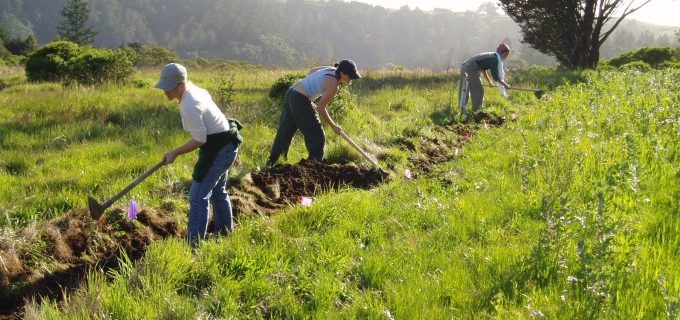Out of the ashes: Rebuilding Resilience with our Food and Farming Community in Sonoma
By Caitlin Hachmyer, Land Justice: Re-imagining Land, Food and the Commons in the United States contributing author and farmer, Red H Farm; and Eric Holt-Giménez, Executive Director of Food First and author of A Foodie’s Guide to Capitalism: Understanding the Political Economy of What We Eat
When the rain finally came, we welcomed it more than the first blooms of spring.
For over a week, the Sonoma fires had blazed uncontrolled through our forests, farmlands and cities, terrorizing our communities. Tens of thousands evacuated as thousands of structures burned. Despite the best efforts of community heroes, first responders, and thousands of firefighters from around the world, 40 people died and more than 200,000 acres of rural and urban land were transformed into a charred landscape.
Within 24 hours of the first flames, choking on the smoke, farmers, workers, distributors, and chefs organized to feed people. Farmers pulled products from their smoky fields and from winter storage, loading them onto trucks. Thousands upon thousands of pounds of food came pouring into emergency centers from small-scale farms across the county. The Farmers Guild and FEED Sonoma partnered, calling on Bay Area food networks as far as San Francisco and the South Bay to help them bring in fresh fruits, vegetables, meat and dairy. Restaurants repurposed their kitchens for emergency food service. Tens of thousands of meals were cooked, packed and distributed to the far reaches of the county. As the fires burned, a coalition of organizations called Another World is Possible put together a benefit and created the North Bay Just and Resilient Futures Fund raising more than $100,000. Community members and local businesses donated thousands to the Farmers Guild for impacted farms, farmworkers, and communities. All of this was possible because of the far-flung, yet remarkably well organized local food movement.
People in the food movement are passionate—not just about farming or a good, justly-produced meal. They sow justice as well as grow food. The extensive solidarity and collaboration in the face of the fires don’t just happen because of a desire for better food. They happen because of a widely-shared belief that another world is possible.
We’re still in shock over the fire’s staggering damage to lives and livelihoods. Still, we pause to thank each other… in the fields, the kitchens, and the emergency centers, for coming together. Reflecting on what just happened, we ask ourselves, “What might be possible?”
The sheer impact of the fires laid bare our social inequities as well as our environmental vulnerabilities. It also brought out our bravest, smartest, and most compassionate natures as we reached across the wine country’s diverse landscape to face the inferno. Our local food system turned out to be not just a culinary treasure, but a pillar of social resilience.
Stay in the loop with Food First!
Get our independent analysis, research, and other publications you care about to your inbox for free!
Sign up today!The incidents of extended droughts and severe storms are increasing, along with related climate hazards like fire, floods, and massive slides. One way or another, our food—and the farmers and workers who bring it to our table—will be a key part of future mitigation and relief efforts. To build strong regional resiliency, we need a reconstruction strategy that invests in a strong local food system.
Our farm community—while thriving—lives on the economic fringes of a beautiful, enviably wealthy, agrarian region. What of the farmers who lost homes, crops, and livelihoods to the blaze? What of the undocumented workers too frightened to go to evacuation shelters, and the farmworkers unable to regain lost income? Normalized immigration status, affordable housing, and sustainable farmland access—pressing needs before the fires—are now urgent.
As we ready our spirits for the task of reconstruction, we have an opportunity to create a more local, resilient and equitable food system, one that lowers our risk and buffers everyone from climate-related disasters—including the ones who grow our food.


 Help Food First to continue growing an informed, transformative, and flourishing food movement.
Help Food First to continue growing an informed, transformative, and flourishing food movement.




